
by Alex Demolitor | Aug 14, 2024 | CPI, Monthly CPI Updates
The July 2024 Consumer Price Index of All Urban Consumers (CPI-U) report indicates that inflation increased by 0.2% for the month, a rise from June’s 0.1% decline. These data were released at 8:30 am EST on Wednesday, August 14, 2024, by the Bureau of Labor Statistics. Before seasonal adjustment, the year-over-year (Y-o-Y) inflation rate in the all-items index grew by 2.9%, decelerating from June’s 3.0% Y-o-Y CPI print.
Doing little to derail the chances of future rate cuts, most of the CPI metrics matched economists’ consensus estimates. The table below is courtesy of Investing.com. The left column represents July’s figures, while the right column represents forecasters’ expectations. As you can see, the Y-o-Y CPI (marked in red) was weaker than expected, while the others (marked in black) met expectations.

To that point, while Fed Chairman Jerome Powell said on Jul. 31 that “we’re not quite at that point” where a lower overnight lending rate is justified, he added, “We’re getting closer to the point at which it’ll be appropriate to reduce our policy rate.”
Moreover, the FOMC’s latest Monetary Policy Statement noted that “The Committee judges that the risks to achieving its employment and inflation goals continue to move into better balance.” In other words, the FOMC has become more attentive to a slowing U.S. labor market, which may pave the way for less emphasis on inflation and foster monetary easing.
Global markets had a mixed response to the CPI release, with American and European indices largely remaining range-bound. Likewise, Treasury bonds, precious metals, and the U.S. dollar had mostly small reactions since the as-expected CPI data wasn’t much of a surprise.
July’s headline inflation deceleration was driven by lower used cars and trucks prices (-2.3%), utility gas (-0.7%), and apparel (-0.4%). Core inflation (which excludes the impacts of food and energy), rose 0.2% in July, a small increase from June’s 0.1% rise. The shelter index rose 0.4% and accounted for nearly 90% of the headline CPI’s rise.

Food Prices
The food index increased by 0.2% in July, matching the 0.2% print from June. Three of the six major grocery store food indexes showcased inflation, while three realized deflation.
- Cereals and bakery products (-0.5%)
- Meats, poultry, fish, and eggs (+0.7%)
- Dairy and related products (-0.2%)
- Fruits and vegetables (+0.8%)
- Nonalcoholic beverages (+0.5%)
- Other food at home (-0.5%)
In addition, the food away from home index rose by 0.2% in July, a noticeable slowdown from the 0.4% recorded in May and June. Consequently, restaurants pared back some of their pricing practices this month.
Energy Prices
The energy index was flat in July after falling 2.0% in June. Electricity and fuel oil prices rose by 0.1% and 0.9%, respectively, while natural gas prices fell by 0.7%. Gasoline prices were also flat in July on a seasonally adjusted basis and up by 0.8% excluding adjustments.
Core CPI July 2024
The July core CPI rose by 0.2% month-over-month, which is within the Fed’s range of expectations. On a Y-o-Y basis, the metric rose 3.2%. Below is an itemized breakdown of the main price fluctuations seen in the core CPI reading:
- Shelter index: (+0.4%) [June: +0.2%]
- Rent index: (+0.5%) [June: +0.3%]
- Owners’ equivalent rent: (+0.4%) [June: +0.3%]
- Motor vehicle insurance: (+1.2%) [June: +0.9%]
- Medical care services: (-0.3%) [June: +0.2%]
- Physician services: (+0.1%) [June: +0.1%]
- Hospital services: (-1.1%) [June: +0.1%]
- Airline fares: (-1.6%) [June: -5.0%]

Seasonally Unadjusted CPI Data for July 2024
Before seasonal adjustments, the CPI-U for July 2024 increased (+2.9%) Y-o-Y, rising to an index level of 314.540. Since these figures are unadjusted, they include regular seasonal price fluctuations that can create volatility in the results.

Growth Concerns Overshadow Inflation?
Because price stability is only one-half of the Fed’s dual mandate, investors always worry that too much emphasis on inflation could slow economic growth and derail the other half of the dual mandate — maximum employment.
As a result, while the financial markets have stabilized in recent days, last week’s ‘flash crash’ and calls for emergency rate cuts highlight the anxiety that occurs alongside rate-cutting cycles. Historically, rate cuts have sometimes preceded recessions, so investors are looking for clues that a hard landing can be avoided. Thus, weaker data is good for financial assets as long as it’s not too weak.
Consequently, 2024 winners like Bitcoin and Ethereum have suffered recently, as have U.S. stocks. And while silver has fallen below the important $30 level, gold has largely maintained its strength. Therefore, the yellow metal has shown an ability to perform during good and bad periods throughout 2024.
Are you thinking about diversifying into precious metals? Talk to your financial advisor about initiating a gold IRA account today, allowing you to invest in this red-hot asset on a tax-advantaged basis. Additionally, our complimentary CPI inflation calculator remains at your disposal, enabling you to assess inflation’s impact on your finances. Remember, seek the guidance of a financial advisor before making any investment decision.

by Alex Demolitor | Jul 11, 2024 | CPI
The June 2024 Consumer Price Index of All Urban Consumers (CPI-U) report indicates that inflation declined by 0.1% for the month, a slight drop from May’s flat print (+0.0%). These data were released at 8:30 am EST on Thursday, July 11, 2024, by the Bureau of Labor Statistics. Before seasonal adjustment, the year-over-year (Y-o-Y) inflation rate in the all-items index grew by 3.0%, which is also a drop from May’s 3.3% Y-o-Y CPI reading.
Increasing the chances of a rate cut in the months ahead, the headline and core CPIs came in below economists’ consensus estimates. The table below is courtesy of Investing.com. The left column represents June’s figures, while the right column represents forecasters’ expectations. As you can see, the monthly and Y-o-Y CPIs (marked in red) were weaker than expected.

Yet, while U.S. Federal Reserve Chairman Jerome Powell said on Jul. 10 that “I do have some confidence” that inflation will return to 2%, he cautioned, “I am not ready to say” rate cuts are necessary. “There is a path to getting back to full price stability while keeping the unemployment rate low,” Powell added. “We’re on it. We’re very focused on staying on that path.”
Furthermore, with the U.S. presidential election scheduled for November, he reiterated, “Our undertaking is to make decisions when and as they need to be made, based on the data, the incoming data, the evolving outlook, and the balance of risks, and not in consideration of other factors, and that would include political factors.”
Thus, while Powell has to weigh several variables, June’s weak CPI print should have him feeling more confident about the FOMC’s projections.
Global markets had a mixed response to the CPI slowdown, with American and European indices gyrating, while Treasury bonds and precious metals rallied and the U.S. dollar slumped. Rate cuts by the Fed could help turn the tide for the CAD, which has underperformed the USD in recent months.
June’s headline inflation deceleration was driven by lower gasoline prices (-3.8%), used cars and trucks (-1.5%), electricity (-0.7%), and transportation services (-0.5%). Core inflation (which excludes the impacts of food and energy), rose 0.1% in June, the weakest monthly reading since August 2021. The shelter index rose 0.2%, with rents up 0.3%. Both were also the smallest increases since August 2021.

Source: Bureau of Labor Statistics
Food Prices
The food index increased by 0.2% in June after rising 0.1% in May. Tomatoes fell by 3.3%, breakfast cereal by 2.0%, while pork chops were up 3.1% and eggs up 3.5%. Four of the six major grocery store food indexes showcased inflation, while two realized deflation.
- Cereals and bakery products (-0.1%)
- Meats, poultry, fish, and eggs (+0.2%)
- Dairy and related products (+0.6%)
- Fruits and vegetables (-0.5%)
- Nonalcoholic beverages (+0.1%)
- Other food at home (+0.5%)
In addition, the food away from home index jumped 0.4% in June matching the results from May. Consequently, restaurants continue to demonstrate resilient pricing power.
Energy Prices
The energy index dropped 2.0% in June, on par with the 2.0% drop in May. Gasoline, electricity, and fuel oil prices fell by 3.8%, 0.7%, and 2.4%, respectively, while natural gas prices rose by 2.4%
Core CPI June 2024
The June core CPI rose by 0.1% month-over-month, the lowest monthly print in 2024. On a Y-o-Y basis, the metric rose 3.3%. Below is an itemized breakdown of the main price fluctuations seen in the core CPI reading:
- Shelter index: (+0.2%) [May: +0.4%]
- Rent index: (+0.3%) [May: +0.4%]
- Owners’ equivalent rent: (+0.3%) [May: +0.4%]
- Motor vehicle insurance: (+0.9%) [May: -0.1%]
- Medical care services: (+0.2%) [May: +0.3%]
- Physician services: (+0.1%) [May: +0.0%]
- Hospital services: (+0.1%) [May: +0.5%]
- Airline fares: (-3.6%) [May: -5.0%]

Source: Bureau of Labor Statistics
Seasonally Unadjusted CPI Data for June 2024
Before seasonal adjustments, the CPI-U for June 2024 increased (+3.0%) Y-o-Y, rising to an index level of 314.175. Since these figures are unadjusted, they include regular seasonal price fluctuations that can create volatility in the results.

Source: Bureau of Labor Statistics
Gold and Silver Still Shining Bright
With the CPI slowdown suppressing Treasury yields and weakening the U.S. dollar, gold remains one of the best-performing assets in 2024. Similarly, silver has soared above $30 an ounce, reaching its highest level in more than a decade. Because precious metals futures contracts are priced in USD, a weaker greenback makes it more affordable for foreign investors to purchase the pair. As such, lower Treasury yields, a weaker dollar, and increased rate-cut enthusiasm create a profitable environment for precious metals enthusiasts.
However, the CPI release noted how gasoline prices declined by 3.6% and 3.8% in May and June. And with crude oil prices rising recently, they usually impact gasoline prices with a lag. As a result, the gasoline index should rise in July and temper some of the downward CPI momentum.
All in all, while 2024 winners like gold, silver, Bitcoin, and Ethereum should maintain their strength absent a recession, the same could be said for U.S. stocks. The S&P 500 and NASDAQ have also rallied sharply in 2024, but big tests loom over the next few weeks. With some of the index’s largest constituents — like Apple, Microsoft, and Meta Platforms — reporting earnings soon, investors expect upbeat results.
Are you thinking about diversifying into precious metals? Talk to your financial advisor about initiating a gold IRA account today, allowing you to invest in this red-hot asset on a tax-advantaged basis. Additionally, our complimentary CPI inflation calculator remains at your disposal, enabling you to assess inflation’s impact on your finances. Remember, seek the guidance of a financial advisor before making any investment decision.
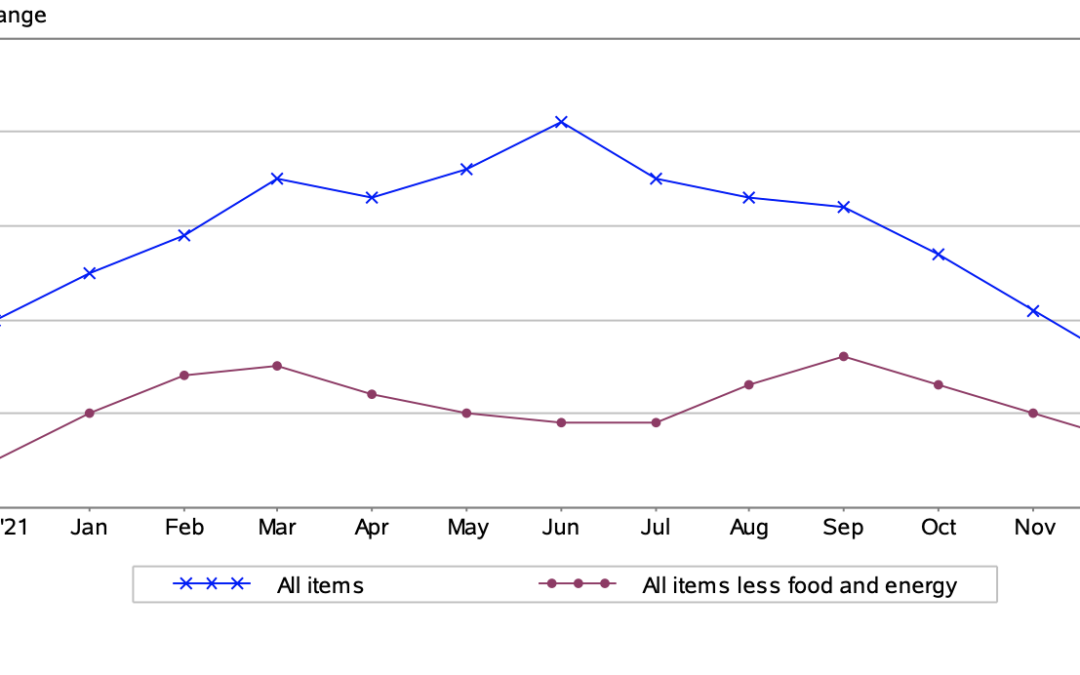
by Sarah Bauder | Jan 12, 2023 | CPI
The Consumer Price Index for All Urban Consumers (CPI-U) decreased by 0.1% on a seasonally adjusted basis, reported the Bureau of Labor Statistics. Year-over-year, before seasonal adjustment the all items index grew by 6.5%.
The primary contributing variable to the deceleration in inflation was the drop in the price of gasoline. The price of foodstuffs at grocery stores increased, as did shelter costs, albeit at a slower pace.
Despite the fact that inflation in the United States appears to be slowing down, the Federal Reserve has indicated that more interest rate hikes will transpire into 2023 to curtail the soaring cost of living.
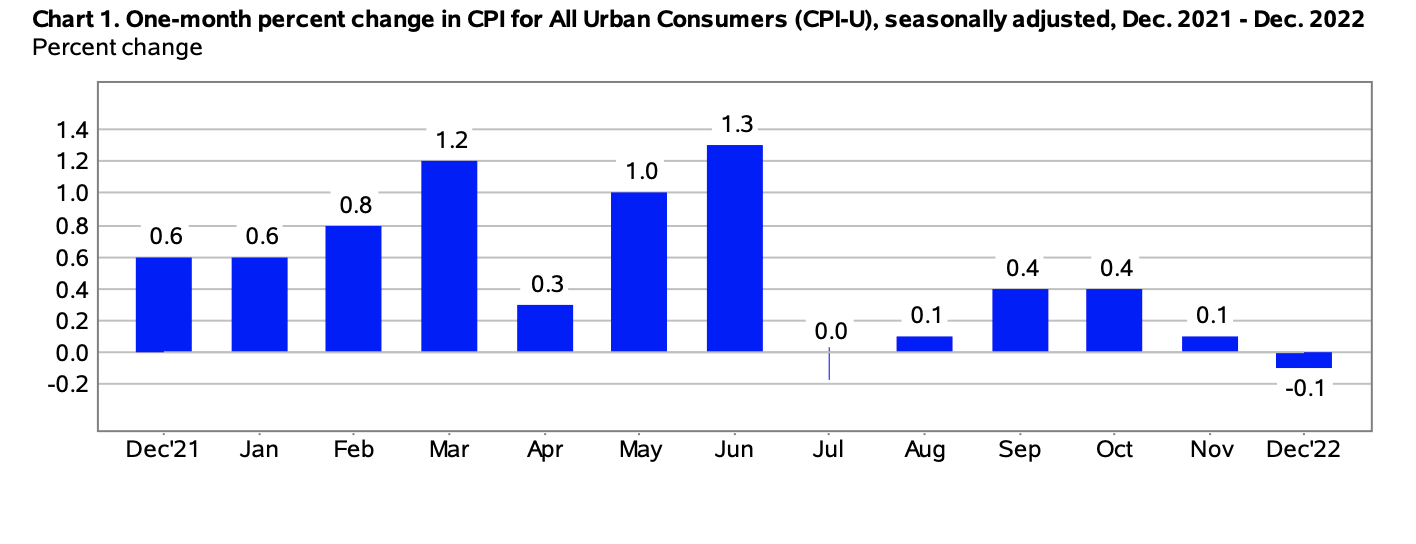
(Source: U.S. Bureau of Labor Statistics)
Food
In December, the index for food rose by 0.3%, after a 0.5% increase from the previous month. Over the last 12-month span, American consumers have paid 11.8% more for food items from grocery stores.
Grocery items that saw price increases in December included meats, poultry, fish, and eggs. Conversely, the prices for fresh fruits and vegetables and bakery products declined. Moreover, American consumers paid more to dine out in restaurants in December.
Gasoline Prices
In December, American consumers again paid less to gas up their vehicles. The price of gasoline dropped by 9.4% over the month, after the 2% decrease seen in November.
In December, prior to seasonal adjustment, the price of gasoline declined 12.5%.
Since this time last year, gasoline prices have decreased by 1.5%.
Energy
In December, the index for energy dropped 4.5%. This was primarily due to the decline in gasoline prices. However, American consumers paid 3% more for natural gas and 1% more for electricity over the month.
Year-over-year, the index for energy grew by 7.3%. Since this time last year, fuel oil prices surged by 41.5%. Likewise, American consumers paid 19.3% more for natural gas and 14.3% more for electricity over the last 12-month period.
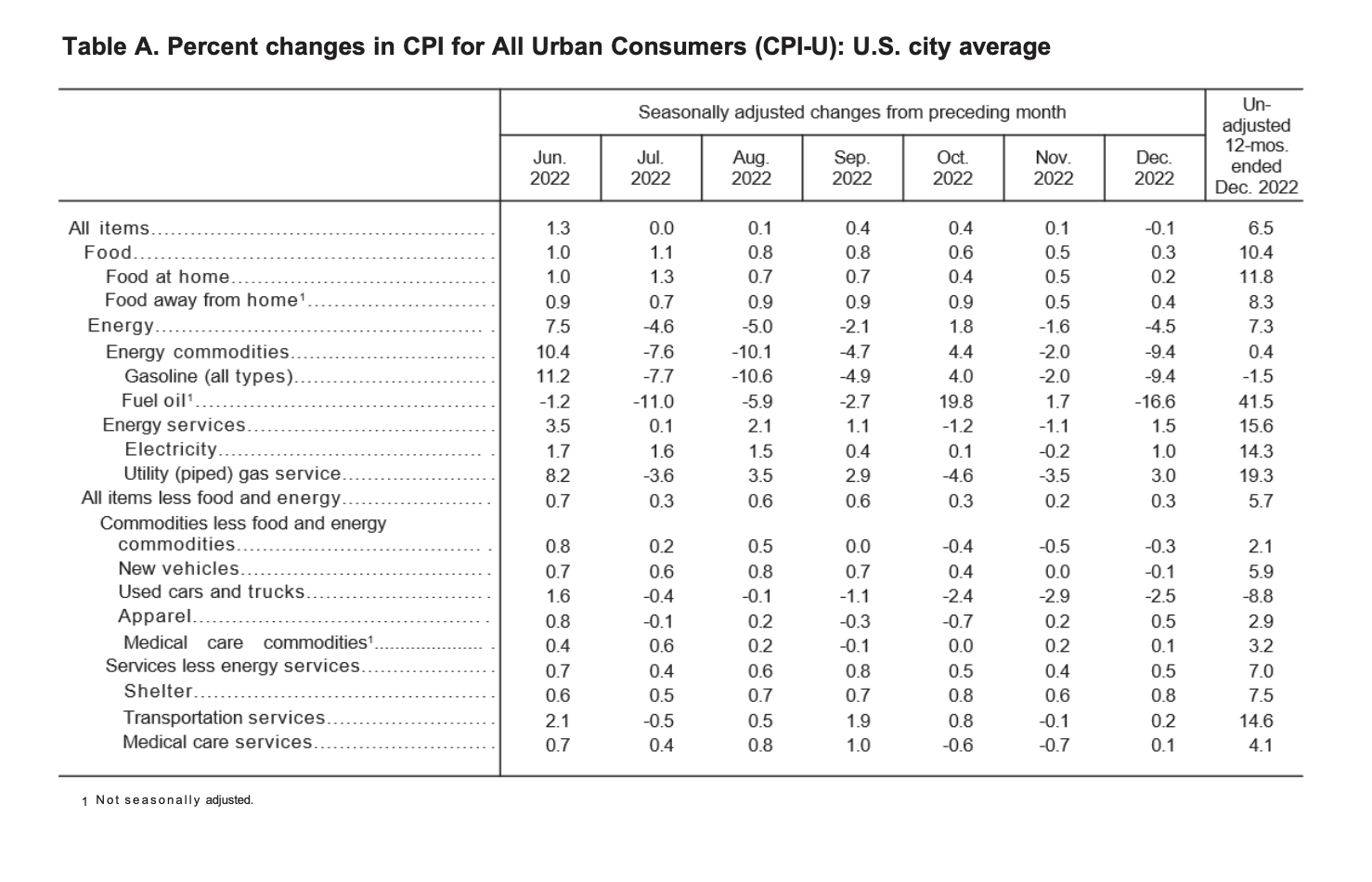
(Source: U.S. Bureau of Labor Statistics)
All Items Less Food and Energy
In December, the all items less food and energy index edged up 0.3%. Unfortunately, American consumers continued to pay more shelter costs. The index for shelter rose 0.8% over the month.
Both the index for rent and the index for owners’ equivalent rent (which is correlated to the value of housing prices) increased by 0.8%, respectively.
“The shelter index was the dominant factor in the monthly increase in the index for all items less food and energy, while other components were a mix of increases and declines,” explained the Bureau of Labor Statistics in its monthly report.
Over the last 12-month period, the composite index for shelter increased by 7.5% – the most significant contributor to the overall percentage increase of the all items less food and energy index.
Other composite indexes that saw percentage increases since this time last year include furnishings and operations (+6.7%), new vehicles (+5.9%), recreation (+5.1%), and medical care (+4.0%).
Year-over-year, the all items less food and energy index increased by 5.7%.
Want to learn more about how inflation is impacting the economy? Have a look at our table highlighting information regarding the 2022 CPI and Inflation Rate for the United States, try our calculator widget, and subscribe to our newsletter.
Source Cited: https://www.bls.gov/news.release/cpi.nr0.htm
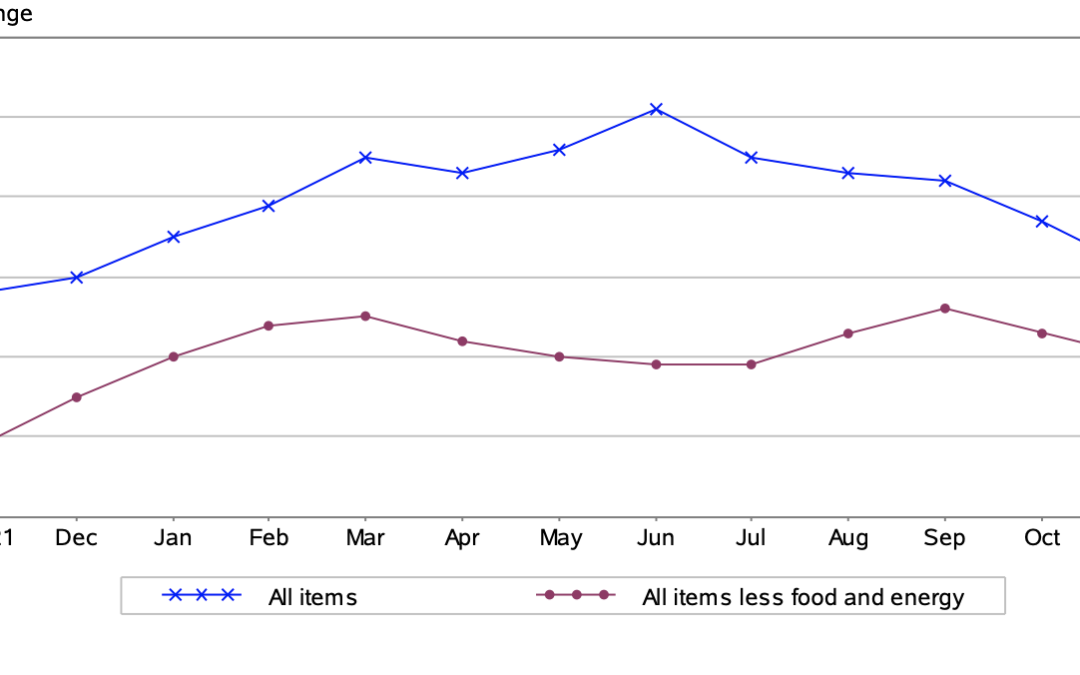
by Sarah Bauder | Dec 13, 2022 | CPI
The Consumer Price Index for All Urban Consumers (CPI-U) rose by 0.1% on a seasonally adjusted basis in November, reported the U.S. Bureau of Labor Statistics. Year-over-year, prior to seasonal adjustment the all items index rose 7.1%.
The primary factor for the percentage increase seen in November was the rise in the shelter index. In addition, the cost of foodstuffs at grocery stores increased, while energy costs declined over the month.
“The index for shelter was by far the largest contributor to the monthly all items increase, more than offsetting decreases in energy indexes,” explained the Bureau of Labor Statistics in its monthly report.
For American consumers, this means that they paid more for shelter costs and foodstuffs at grocery stores. Despite the fact that inflation decelerated in November, many Americans are finding it challenging to meet their daily needs.
In November, based on the data inflation cooled in the United States. For its part, the Fed is expected to slow its interest rate hikes in December.
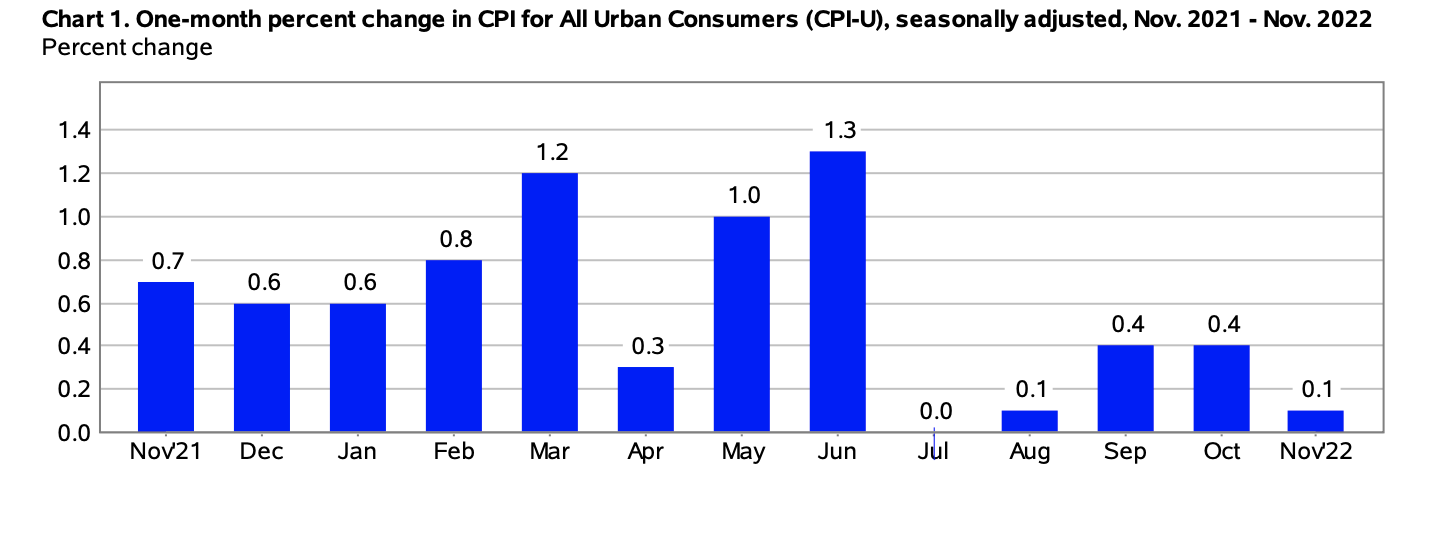
(Source: U.S. Bureau of Labor Statistics)
Food
In November, the index for food rose 0.5%. Moreover, foodstuffs purchased from a grocery store (the food at home index) increased 0.5% over the month. Over the last 12-month period, American consumers paid 12% more for food from grocery stores.
Grocery items that were the main contributors to the overall rise in the index included fruits and vegetables, cereal products, bakery products, and nonalcoholic beverages. Conversely, the composite index for meats, poultry, fish, and eggs dropped 0.2%, the index for beef fell 0.8%, and the pork index dropped 0.3%, respectively, in November.
The Price of Gasoline
American consumers paid less for gasoline at the pumps over the month. The price of gasoline declined by 2% in November, after the 4% rise seen the previous month.
In November, prior to seasonal adjustment, the price of gasoline dropped 3.6%.
Year-over-year, the price of gasoline has risen by 10.1%.
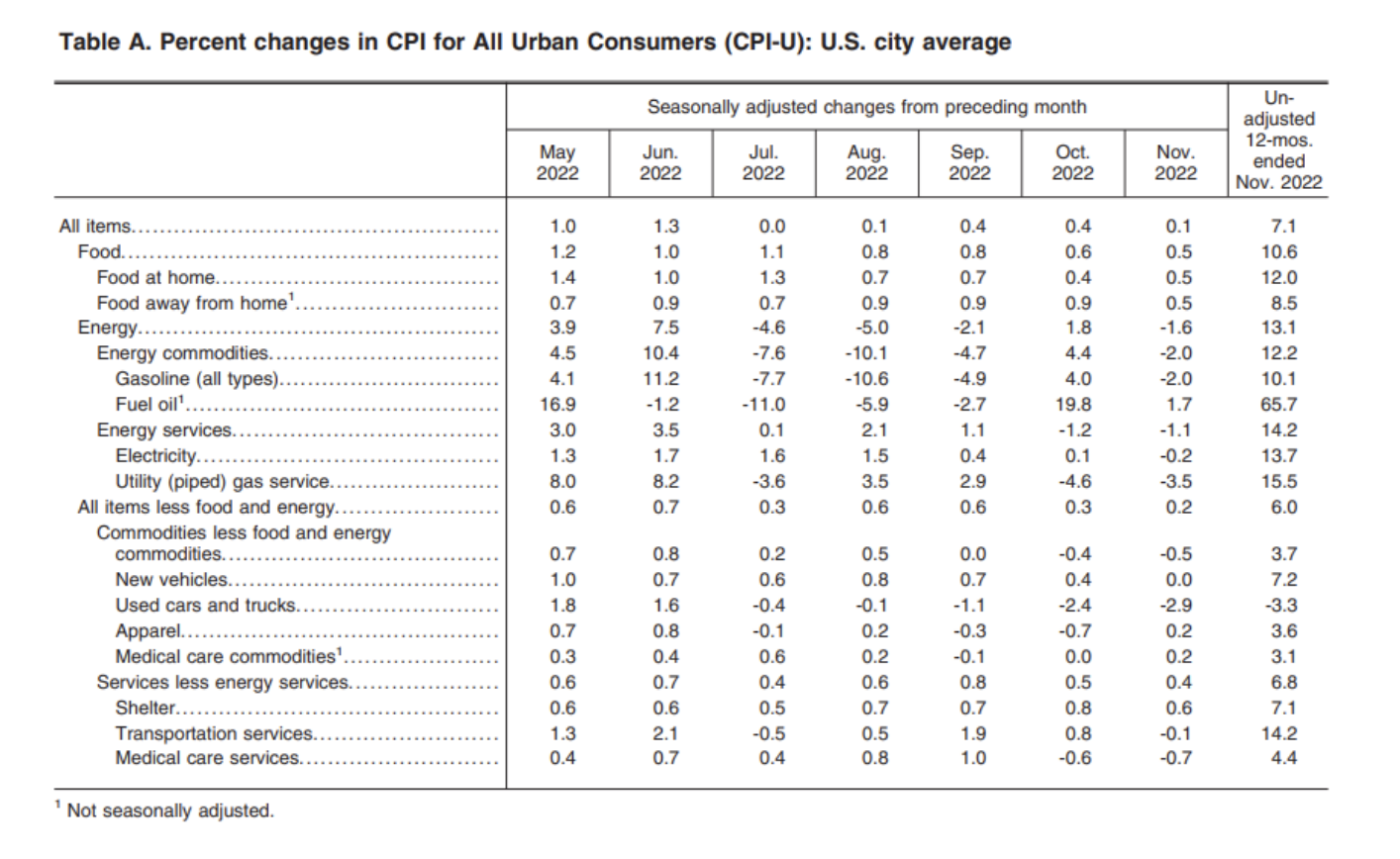
(Source: U.S. Bureau of Labor Statistics)
Energy
In November, the index for energy declined 1.6%, largely because of the decrease in the respective prices of gasoline, natural gas, and electricity.
American consumers paid 3.5% less for natural gas, and 0.2% less for electricity over the month.
Since this time last year, the index for energy grew by 13.1%. Year-over-year, the price of fuel oil skyrocketed an astounding 65.7%. In addition, American consumers paid 15.5% more for natural gas and 13.7% more for electricity since this time last year.
All Items Less Food and Energy
In November, the all items less food and energy index edged up 0.2%. Americans continued to pay more shelter themselves, as the index rose 0.6% over the month.
Furthermore, rent prices also increased by 0.8%, and the index for owners’ equivalent rent, which is correlated to the value of housing prices, rose 0.7% over the month.
The US Bureau of Labor Statistics noted that the index for shelter was the primary factor for the monthly rise in the percentage of the all items less food and energy index.
Year-over-year, the all items less food and energy index increased by 6%. Over the last 12-month span, the composite index for shelter rose 7.1%. Additionally, the index for medical care grew by 4.2% and new vehicles cost American consumers 7.2% more since thos time last year.
Want to learn more about how inflation is impacting the economy? Here is our table highlighting the 2022 CPI and Inflation Rate for the United States, try our U.S. inflation calculator, and subscribe to our newsletter.
Source Cited: https://www.bls.gov/news.release/archives/cpi_12132022.htm
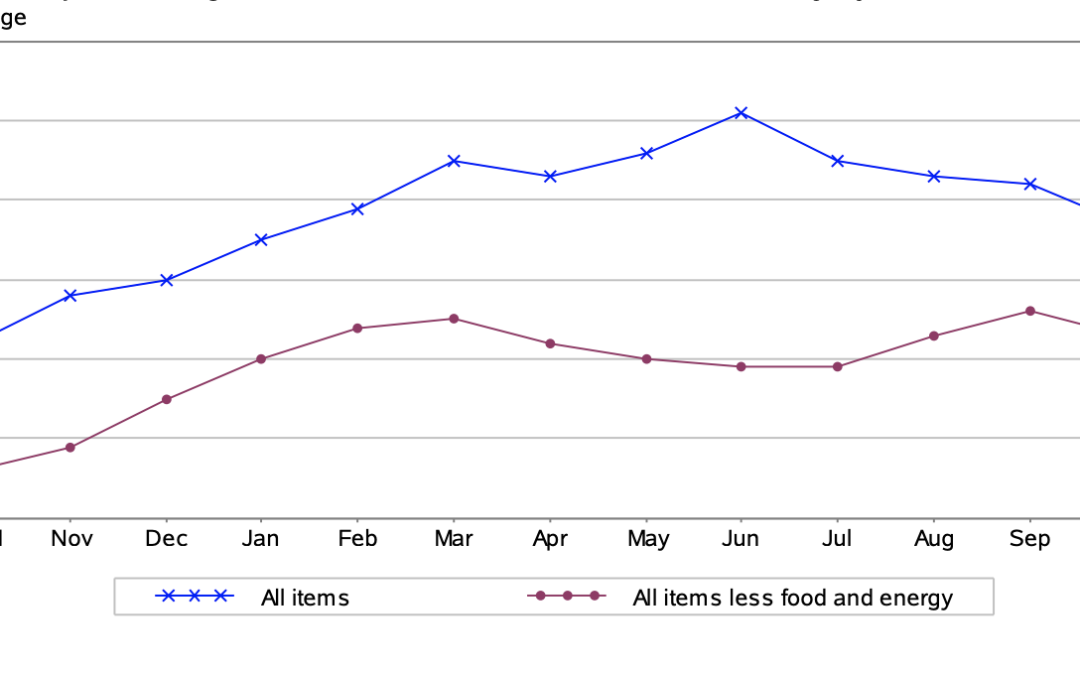
by Sarah Bauder | Nov 10, 2022 | CPI
The Consumer Price Index for All Urban Consumers (CPI-U) edged up by 0.4% on a seasonally adjusted basis in October, reported the U.S. Bureau of Labor Statistics. This is the identical percentage increase seen in September. Year-over-year, prior to seasonal adjustment the all items index rose by 7.7%.
The primary contributors to the percentage rise seen in October were a rise in shelter costs, food, and the price of gasoline.
“The index for shelter contributed over half of the monthly all items increase, with the indexes for gasoline and food also increasing,” explained the Bureau of Labor Statistics in its monthly report.
For American consumers, this means they paid more for shelter costs, and food items at grocery stores, in addition to paying more at the gas pumps. Ultimately, this denotes that many Americans are still contending with meeting basic daily needs.
Despite the fact that core inflation decelerated in October, nonetheless, the Federal Reserve increased interest rates to their highest levels since 2008.
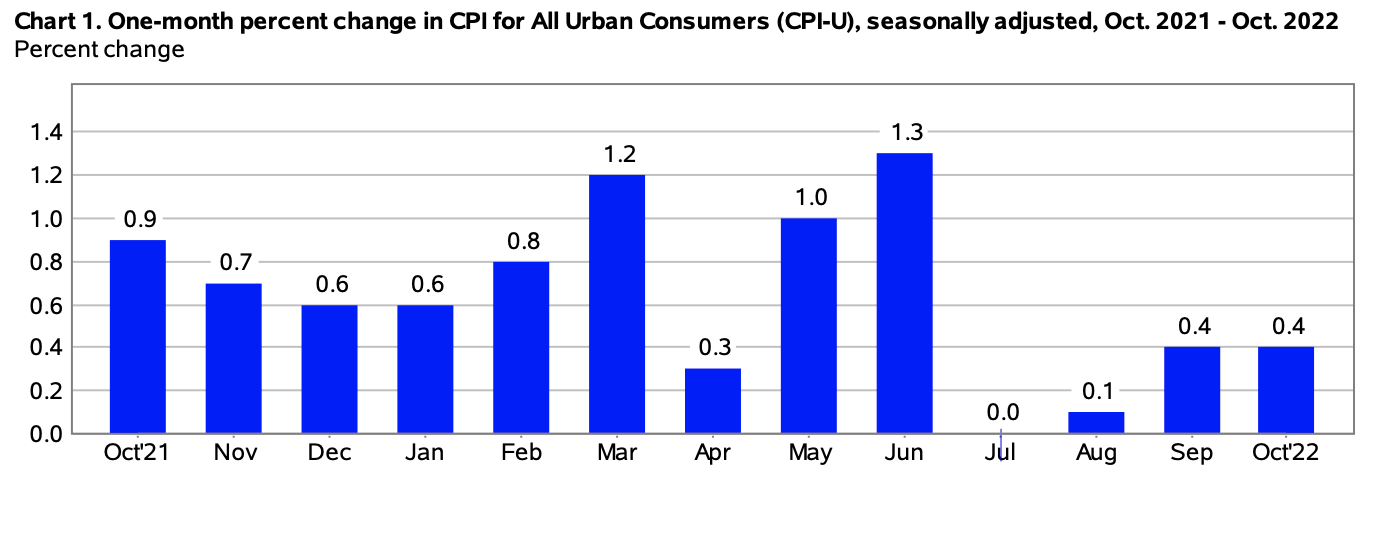
(Source: U.S. Bureau of Labor Statistics)
Food
In October, the index for food rose 0.6%. The index for food at home, which indicates foodstuffs at grocery stores increased by 0.4%. It should be noted that this marks the lowest monthly percentage increase seen since December 2021.
Since this time last year, American consumers have paid more for food items bought at grocery stores, as the index for food at home increased by 12.4%. Year-over-year, grocery items that were the main contributors to the overall increase in the index included cereals and bakery products, dairy and related products, in addition to meats, poultry, fish, and eggs.
Gas Prices
American consumers paid more at the gas pumps in October. Gas prices increased by 4% in October, after consumers enjoyed a bit of respite with lower prices for gasoline seen over the previous three months.
In October, prior to seasonal adjustment, the price of gasoline increased by 3.1%.
Over the last 12-month period, the price of gasoline rose by 17.5%.

(Source: U.S. Bureau of Labor Statistics)
All Items Less Food and Energy
In October, the all items less food and energy index increased 0.3%. American consumers continued to pay more for shelter, as the index grew 0.8% over the month. It should be noted that this is the largest monthly rise in shelter costs since August 1990.
Furthermore, rent prices also rose 0.7%, as did the index for owners’ equivalent rent by 0.6%, which is correlated to the value of housing prices.
Conversely, Americans paid less for medical costs in October. The index for medical care dropped 0.5%. Over the month, major medical care composite indexes saw percentage declines. The hospital services index fell 0.2%, and the price of prescription drugs dropped 0.1%.
Year-over-year, the all items less food and energy index increased by 6.3%. Over the last 12-month span, 6.9%. Likewise, the index for medical care increased by 5% since this time last year.
Want to learn more about how inflation is impacting the economy? Here is our table highlighting the 2022 CPI and Inflation Rate for the United States, try our U.S. inflation calculator, and subscribe to our newsletter.
Source Cited: https://www.bls.gov/news.release/archives/cpi_11102022.htm
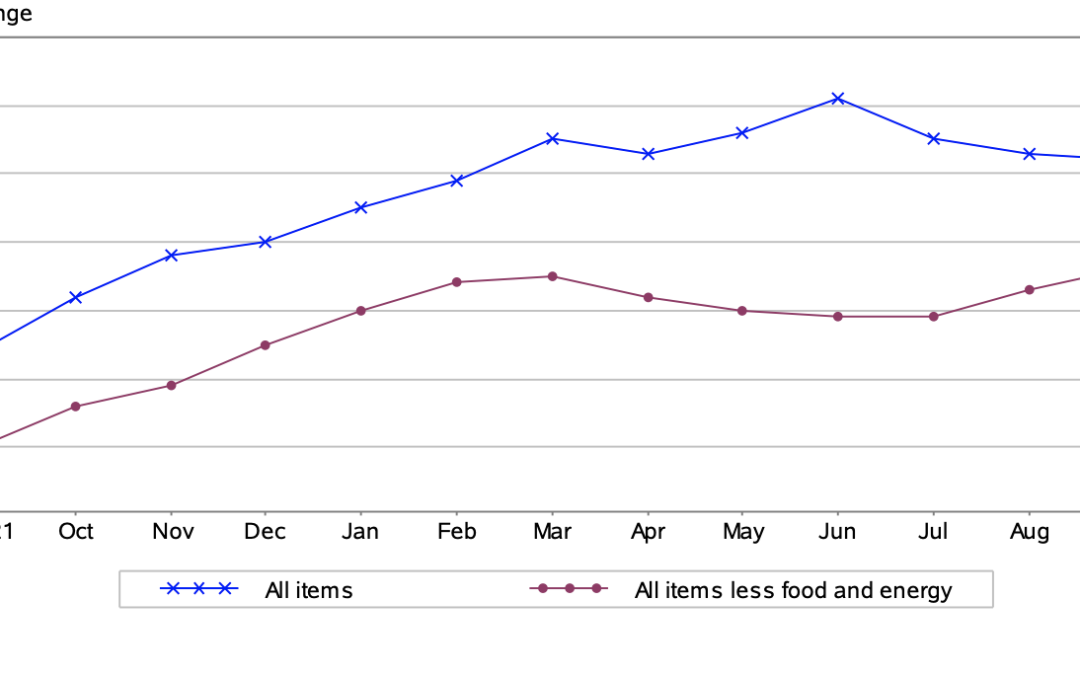
by Sarah Bauder | Oct 13, 2022 | CPI
The Consumer Price Index for All Urban Consumers (CPI-U) increased 0.4% on a seasonally adjusted basis, reported the Bureau of Labor Statistics. Year-over-year, before seasonal adjustment the all items index grew by 8.2%.
The primary reason for the percentage increase seen in September was the food, shelter, and medical care indexes. However, a 4.9% decline in gas prices compensated for the percentage rise seen in other indexes.
For American consumers, unfortunately, this means an increase in the prices of foodstuffs from grocery stores. Likewise, Americans paid more for medical care and shelter costs in September. Although inflation cooled slightly for the month, prices for daily necessities continue to rise. Given this fact, the Federal Reserve has indicated that higher interest rates will remain, until the prices of goods begin to decline.
Energy
In September, the index for energy dropped 2.1%. Americans paid less at the pumps, as gasoline prices decreased over the month. Yet, the natural gas index rose 2.9%, as did the index for electricity, which edged up 0.4% in September.
Over the last 12-month period, the index for energy grew by 19.8%. Year-over-year, fuel oil prices skyrocketed by 58.1%. Furthermore, the price of natural gas soared 33.1%, and electricity prices 15.5% since this time last year.
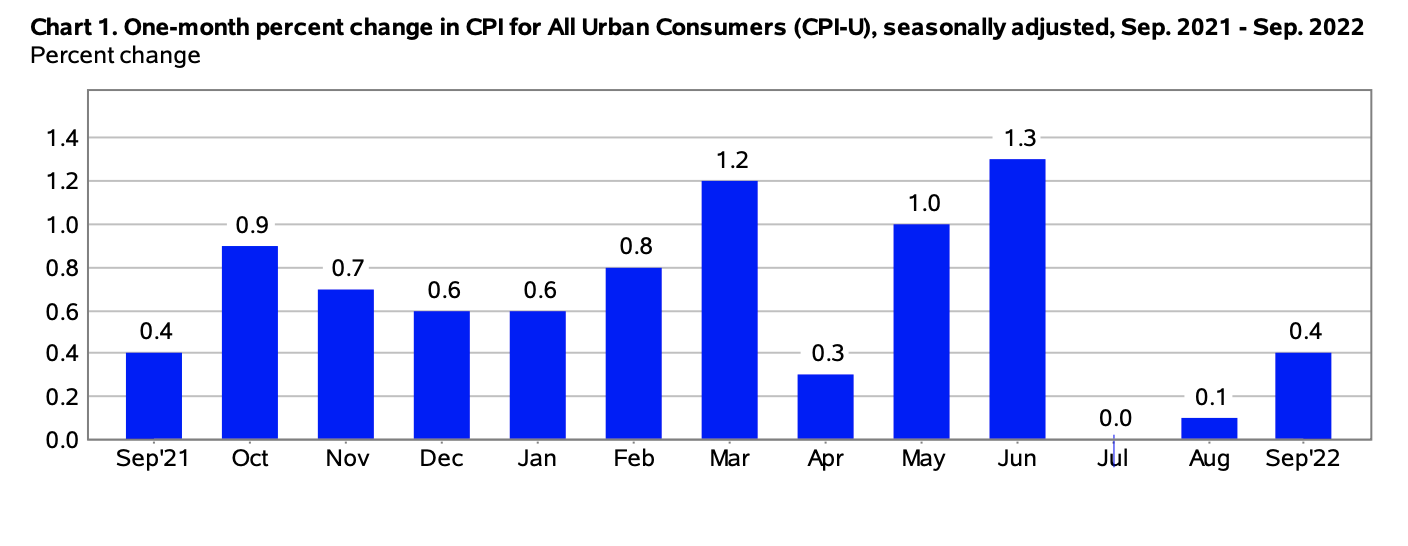
(Source: U.S. Bureau of Labor Statistics)
Gasoline Prices
In September, American consumers once again paid less at the pumps. The price of gasoline declined 4.9% over the month. This marks the third consecutive monthly drop in the price of gasoline, after the 10.6% drop seen in August, and the 7.7% decrease in July.
In September, prior to seasonal adjustment, gasoline prices declined by 5.6%.
Year-over-year, the price of gasoline rose by 18.2%.
Food
In September, the index for food edged up 0.8%, the identical percentage increase seen in August. Over the last 12-month period, American consumers have paid 13% more for food items from grocery stores.
Foodstuffs that saw the largest price increase in September included fruits and vegetables (1.6%), cereals and bakery products (0.9%), meats, poultry, fish, and eggs (0.4%), and non-alcoholic beverages (0.6%). Furthermore, as in August, American consumers paid more to dine out in restaurants in September.
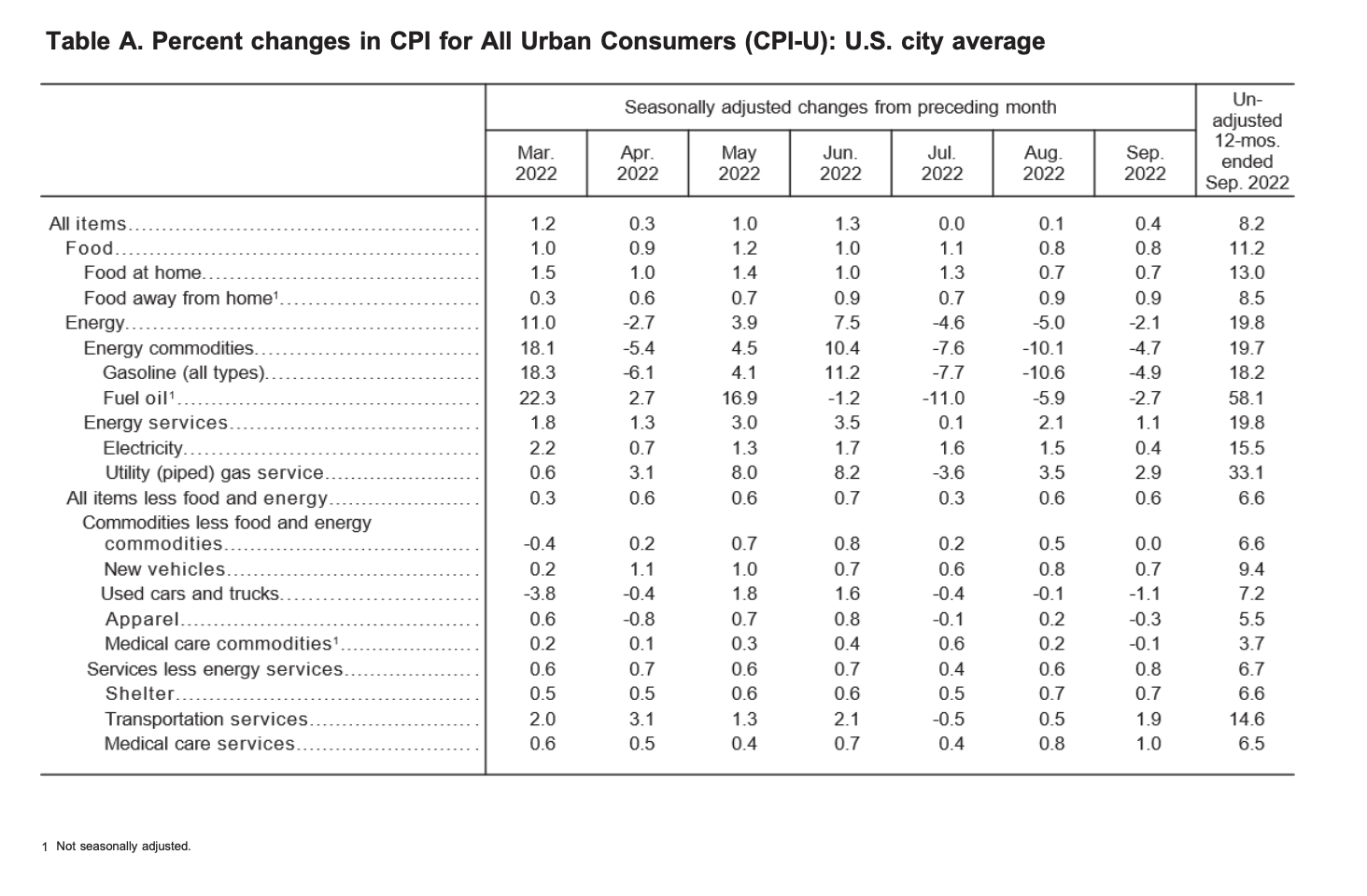
(Source: U.S. Bureau of Labor Statistics)
All Items Less Food and Energy
In September, the all items less food and energy index increased by 0.6%, the same percentage increase seen the previous month. American consumers continued to pay more shelter costs. The index for shelter rose 0.7% for the month.
The index for rent edged up by 0.8%, as did the index for owners’ equivalent rent, which is correlated to the value of housing prices. Furthermore, Americans paid more for medical care, as the medical care index increased by 0.8% in September. The physicians’ services index rose 0.5%, as did the hospital services index by 0.1%.
Conversely, Americans paid 0.1% less for prescription drugs in September.
Since this time last year, the all items less food and energy index grew by 6.6%. The Bureau of Labor Statistics noted that this was the largest year-over-year rise in the index in 40 years, specifically since August 1982.
Over the last 12-month period, the composite index for shelter increased by 6.6% – contributing to over 40% of the percentage rise in the all items less food and energy index.
Want to learn more about how inflation is impacting the economy? Have a look at our table highlighting information regarding the 2022 CPI and Inflation Rate for the United States, try our calculator widget, and subscribe to our newsletter.
Source Cited: https://www.bls.gov/news.release/archives/cpi_10132022.htm
























